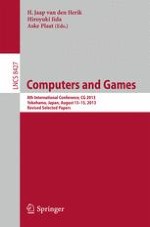2014 | OriginalPaper | Chapter
Comparison Training of Shogi Evaluation Functions with Self-Generated Training Positions and Moves
Authors : Akira Ura, Makoto Miwa, Yoshimasa Tsuruoka, Takashi Chikayama
Published in: Computers and Games
Publisher: Springer International Publishing
Activate our intelligent search to find suitable subject content or patents.
Select sections of text to find matching patents with Artificial Intelligence. powered by
Select sections of text to find additional relevant content using AI-assisted search. powered by
